NASA's Cyclone Global Navigation Satellite System (CYGNSS) could be used to track microplastics in oceans, according to new research conducted by the University of Michigan.
It has been found that microplastics attach themselves to a soapy or oily residue and satellites can spot this type of residue easily. This suggests that satellites can be used to track microplastics from space, which would be a major improvement on current tracking methods. However, the system's limitations need to be fully understood before it is put into widespread use.

Microplastics are tiny plastic particles that are smaller than 5 millimetres in size. They can be of different shapes, sizes, and colours and can come from various sources including cosmetic products, textiles, packaging, and other plastic waste. Microplastics can also originate from the breakdown of larger plastic items.
Once released into the environment, microplastics can be widely distributed by wind, water, and other natural processes. They are able to persist in the environment for hundreds of years, and they can be ingested by marine life and other animals, causing potential harm to their health. Microplastics have been found in oceans, freshwater systems, and even in the air.
Given their small size and persistence in the environment, microplastics have become a growing concern for the health of our planet and its ecosystems. Efforts are underway to reduce the production of microplastics and to increase the recycling and proper disposal of plastic waste.
© Vygr Media Private Limited 2023. All Rights Reserved.
























